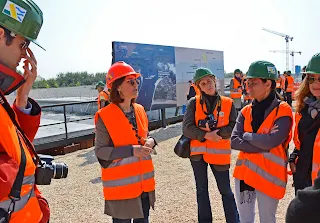I was invited by eve-italia.com to join a tour of the MOSE project, the massive plan to control the water
of the Venetian Lagoon, keep the lagoon vital and protect the buildings of Venice.
This is a large and all encompassing project and two thirds of it is reclaiming land, allowing it to vegetate itself naturally and improve the water quality of the Lagoon.
But the fun parts are the floating dikes which operate to keep the water out of the Lagoon during periods of high tide. Acqua Alta is here to stay, but this program will keep it out of Venice.
I arrived on the isola di San Servolo where the group of engineers and water scientists were meeting, in plenty of time for the 9AM lecture about the Lagoon and its ecosystem. At ten, we all got on board the ship Osvaldo and motored out to the north Lido entrance. There are three entrances to the Lagoon from the Adriatic Sea, the Lido inlet, the Malamocco inlet, and the Chioggia inlet. The Lido inlet is much larger than the others combined and because of that it is the most interesting and complex.
This is the way the inlet is now, after several years of work, historically the inlet was as wide as the distance between the 2 barrier islands. The 'sand bar' in the middle is a new manmade island to support the MOSE system of flood prevention.
On our way out Monica Amberosini of Venezia Nuova described the whole project to us.
A view sailing out the channel to the Adriatic.
We approach the inlet and see the concrete work of the project at the inboard side.
We are kind of on the route taken by the moving boats above, and we end up docking in the large concrete docking area in the middle of the photo. Venice is top right, the Lido is top middle and you can see the shallows in the Lagoon clearly. All the white concrete work on either side of the channel and the island in the middle is new work for this project. The flood gate system starts at the blackish area in the lower area and goes across to the island.
This can be seen clearer in this detail picture.
Those box things are the casings for the gates. We will be standing near the crane.
After we land - nicely- we put on our safety gear and walk over to the casting area...
This is one of those little boxes...10 meters high 100 meters wide and 120 meters long. These are hollow concrete frames for the gates, they will be floated into place and gently lowered by filling the closed half with water. Located exactly with a GPSsystem, they will be secured to the sea bed. Those open 'doors' are over 2 stories high and they form the tunnel and work place for the operation and cleaning of the gates. These will be butted together and a watertight seal will be placed between them.
These blue things are life size models of the hinges...they go where the circle is on the diagram to the left, the gate is yellow and is either down or up. Water level can be seen by a pale blue at the top of the arrow. These Gates are hollow steel, 5 meters high, 20 meters wide and 60 meters long...3 of these to each of the concrete boxes. They stay down because they are filled with water, the raise up by blowing the water out with high pressure air, so that they float. They can be fixed in place once they float to about 45*. Very simple..no big hydraulic systems or anything. The blue in the diagram of the box is water, the grey is concrete, the white is air and the 2 little black things are.........people.
Lots of questions being answered...
We all meander back to the boat and take off...
We pass a gull resting on a new island...
...And we get to the Arsenale in Venice, where we see the large drydock, built by the Austrians about 1900, which will be used for cleaning, repair and painting of the large Gates. The gates will be floated to the arsenal and loaded in to the drydock, just like a cruiser from WWI.
Lots of talk on board..
...About this amazing project to save Venice and its Lagoon...and the work left to do.

















Hi Jonathan! Thank you so much for posting your pictures and explaining the Mose project. We lovers of Venice are always wondering what is happening to that project, particularly after a very bad November this year.
ReplyDelete